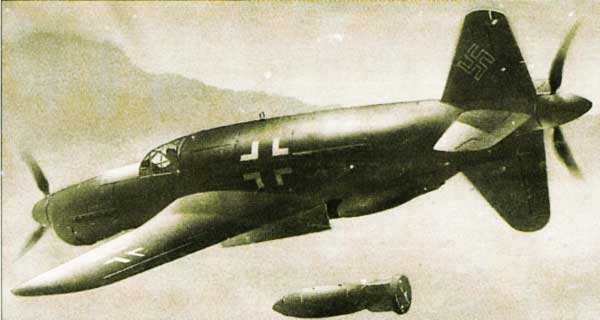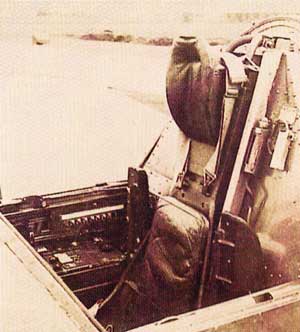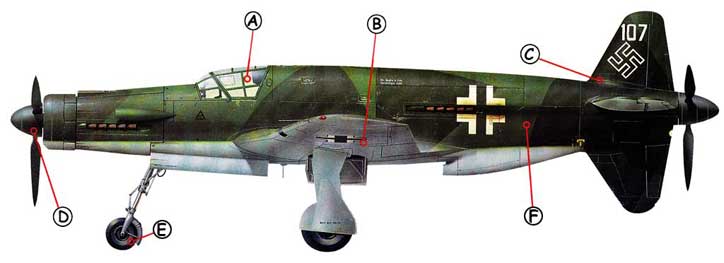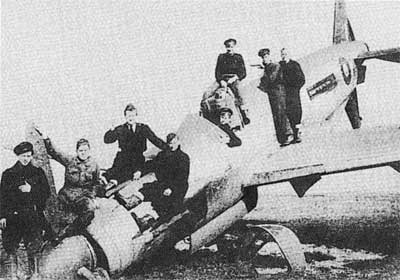

Dornier Do 335 Pfeil (Arrow) Nazi Experimental Fighter


The most unconventional piston engine fighter developed in Germany during the war, the Dornier Do 335 Pfeil(Arrow) had two engines driving 'push-pull' air screws. Two seater night-fighter versions were being produced alongside the single-seat fighter-bomber but neither was finished in time for combat.
During the last brutal years of WWII, the Nazi Luftwaffe was convinced that the answer was to develop new designs. Experimenting with a large number of promising but untried weapons, these were produced in inadequate numbers. While the Luftwaffe was running out of time they still tried aircraft which might have enabled it to stem the vast increase in Allied air power.
Chip..Great model..When I was living near Munich my brother took me to the Deutsches Museum where they had a 'Pfeil' on display!It was about the size of a DC 3 ....Was developed to try to get as high as the allied bombers .....Thanks again for all....Toad

Dornier-335 Nazi Experimental Fighter-1944-1945

Reviving a principle patented in 1937, Dornier designed the radical centerline-thrust Do 335 to a 1942 requirement for a day/night fighter, fighter-bomber and reconnaissance aircraft.
Throughout the history of military aircraft design few successful warplanes justifiably claiming iniquity at their birth have retained this status for any great length of time, the features rendering them unique invariably being plagiarized by their competitors. An exception among piston-engine fighters was the Do 335 which was unique at conception and was destined to remain so.
Popularly known during its brief existence as the Pfeil (Arrow), the Do 335 was radical rather than revolutionary. Its center-line thrust concept was not new in itself. The tandem fore-and-aft engine arrangement for twin-engine fighters stemmed, in fact, from WW I which saw the formula embodied by the Fokker K I and the Siemens-Schuckert DDr 1, both twin-boom aircraft with the engines mounted fore and aft of a pilot seated in a central nacelle.
Between the wars a similar arrangement was adopted for the Chernyshov-designed ANT-23 and the Fokker D XXIII, while in France, Messrs Vernisse and Galtier working at the Arsenal de I'A&onautique displayed rather more ingenuity in achieving the same end with their VG 20 fighter (later redesignated VB 10) which, dispensing with the twin booms, utilized contra-rotating air screws driven through concentric shafts.
The Do 335 offered yet a third variation on the center-line thrust theme, the rear engine driving an air screw aft of a cruciform tail. This unusual air screw position again was not new in itself, for the Tatin-Paulhan Airo-Torpille of 1911 had employed just such an arrangement, but until the d6but of the Do 335 no aircraft had coupled this oddly-situated propeller with m orthodox tractor air screw, the Pfeil thus being rendered unique among combat aircraft.
The periodic revival of interest in the center-line thrust concept was understandable in view of the fighter designer's constant demand for more power than was afforded by contemporary engines and the penalties exacted in the form of increased drag and reduced maneuverability by the adoption of two engines in an orthodox wing-mounted arrangement. With the power from both engines being delivered down the centre-line of the aircraft the desired attributes of minimal frontal area and a clean wing could be obtained, these being coupled with the elimination of power asymmetry in the event of an engine failure, but by and large the complications of the alternative centre-line thrust configurations frustrated their adherents until the Do 335 proved its practicability.

Prof.-Dr. Claudius Dornier had displayed an interest in the potentialities of the centre-line thrust concept from an early phase in his career, utilizing a tandem arrangement of one tractor and one pusher engine for his Gs I flying boat of 1919, and retaining this for many of his subsequent designs, but it was not until the mid 'thirties that he gave active consideration to its adaptation for use by a high-speed combat aircraft.
Prof.Dr. Dornier first patented the configuration in 1937 that was to render the Do 335 unique when it appeared six years later, and to prove the practicability of the aft-mounted air screw with its long extension shaft he commissioned Ulrich Bitter to design a small flying test bed embodying this feature.
Designated the G6ppingen G6 9 and built at Westerberg by Schempp-Hirth, the Hitter-designed test bed had a span of 23 ft. 7,1 in., a length of 22 ft. 334 in., and a gross weight of 1,587 lb., power being provided by an 80 h.p. Hirth HM 60R air-cooled engine mounted beneath the wing at the c.g., and driving a four-bladed wooden air screw aft of a cruciform tail by means of a long transmission shaft.
After protracted ground trials, the G6 9 was eventually flown early in 1940, and during subsequent testing attained 137 m.p.h. in level flight, the pusher air screw and its extension shaft proving extremely efficient. Dornier had, by this time, prepared several project studies for fighters embodying this radical air screw arrangement, but although the Technische Amt of the RLM evinced some interest in the proposals, the Dornier Werke's assigned tasks were the design and construction of bombers and flying boats, and the RLM was most insistent that fighters were not the concern of the company. However, in 1942 the Technische Anit issued a requirement for a single-seat unarmed intruder capable of carrying a 1,100-lb. bomb load at speeds of the order of 495 m.p.h. Arado, Dornier and Junkers submitted proposals to meet the demands of this requirement, and in the subsequent competitive evaluation, Dornier's submission, the Projekt 231 employing the fore-and-aft engine arrangement, was selected as the winning contender.
A development contract was promptly awarded the Projekt 231 which was assigned the RLM designation Do 335, but shortly after detail design had been initiated the Dornier team was informed that the unarmed intruder requirement had been overtaken by a demand for a multi-purpose fighter of broadly similar performance, and was instructed to investigate the possibility of adapting the Do 335 to fulfil the roles of single-seat fighter bomber, high-speed reconnaissance aircraft, heavy Zerst5rer, and two-seat night and all-weather interceptor. The necessary redesign had been completed and the first metal had been cut on the prototypes by the end of 1942 at Oberpfaffenhofen, and when the first example, the Do 335 V1 (CP + UA), flew for the first time on October 26, 4943, contracts had been placed with the Dornier Werke for 14 Versuchs aircraft, 10 pre-production Do 335A-0 and 11 production Do 335A-1 single-seat fighter-bombers, and three Do 335A-10 and A-12 tandem two-seat dual-control conversion trainers.
After preliminary handling trials at Oberpfaffenhofen, the Do 335 VI was ferried to the Rechlin Erprobungsstelle for official trials. Although some snaking and proposing was experienced at high speeds, the Rechlin pilots were generally enthusiastic over the characteristics of the Do 335 VI, commenting favorably on its general handling behavior, maneuverability, and, in particular, its acceleration and turning circle. The aircraft was flown on the power of the forward engine alone and on the aft engine alone, and with forward engine cut and air screw feathered a speed of 348 m.p.h. was clocked in level flight.
During the winter of 1943-44, the first prototype was joined in the test program by several additional aircraft which, like the oil cooler intake was deleted and incorporated in an enlarged annular cowling; criticisms of poor rear vision were overcome by the provision of blisters in the cockpit canopy, these housing small rear-view mirrors, and the main wheel well covers were redesigned, the one-piece circular plates giving place to divided covers, the inboard portions of which were attached to the wing roots. The Do 335 V4 airframe was assigned to the Do 435 development program and was destined never to be completed, still being under construction in the autumn of 1944 when the Do 435 program was cancelled by the RLM. First proposed in the autumn of 1943, the Do 435 was a night and all weather interceptor which, based on the Do 335, was to have featured a simplified structure and side-by-side seating for its two crew members, with cabin pressurization and long-span wooden outer wing panels.
The Do 335 V5 was the first prototype to be fitted with
armament, and with a 30-mm. engine-mounted MK 103 cannon with
70 rounds and two 15-mm. MG 151 cannon with 200 r.p.g. mounted
in the upper decking of the forward fuselage, this aft was delivered
to the Waffenerprobungsstelle at Tarnewitz for firing trials.
The Do 335 V6 and V7 were retained by the Oberpfaffenhofen plant
for various equipment trials, the Do 335 V7 later being transferred
to Junkers at Dessau where it was employed for ground tests with
Jumo 213A and 213E engines throughout the summer of 1944, these
at one time being envisaged as potential alternative power plants
to the DB 603, and the Do 335 V8 was delivered to Daimler-Benz
for installation of the definitive DB 603E-I engines and subsequent
use as an engine test bed.
The Do 335 V9 was completed to pre-production standards with full armament and delivered to the Rechlin Erprobungsstelle in May 1944, being followed off the line by the first Do 335A-0 (Werk-Nr. 101 VG + PG) intended for service evaluation as a single-seat fighter-bomber. Powered by two DB 603A-2 engines and carrying a cannon armament of one 30-mm. MK 103 and two 15-mm. MG 15 1 s, the Do 3 3 5A-0 was an all-metal low-wing cantilever monoplane. The trapezoidal stressed-skin wing featured 13 degrees taper on the leading edge and was built up around a single box spar. Forward of the spar the center section housed a 68 Imp. gal. self-sealing fuel tank on each side of the fuselage, and the trailing edges carried variable-camber flaps inboard of the ailerons. The wings also provided stowage space for the master compass, the armored hydraulic fluid reservoir, and compressed air bottles. The tail assembly was of cruciform type with a cantilever tailplane and upper and lower fins and rudders, the lower fin incorporating a tail bumper with an oleo leg. The tail assembly was covered by metal stressed skin except for the leading edges of the fins which were of wood and housed radio aerials.
The fuselage was an all-metal monocoque. The nose-mounted DB 603A-2 was provided with an annular nose radiator, the aft mounted engine having a ventral scoop radiator. The tractor air screw was of reversible-pitch type, and the pusher air screw was driven via a hollow extension shaft supported by three thrust races. The main fuel tank of 270.5 Imp. gal. capacity was installed aft of the cockpit, together with two 22.4 Imp. gal. oil tanks, and the weapons bay beneath the tank bay could house either one 1,102-lb. PC 500 or SD 500 bomb or two 551-lb. SC 250 bombs. The cockpit was enclosed by a jettisonable canopy which, unlike the aft-sliding canopies of the prototypes, hinged to starboard, and was separated from the tank bay by an armour bulkhead.
 The pilot was provided
with an ejector seat and provision was made for jettisoning the
upper vertical tail surface and rear air screw by means of explosive
bolts which were actuated with the ejector seat. The pilot was
provided with a Revi C 12/13 reflector sight which, mounted on
a Schwenkplatte (swivel-plate) SP 1, could be used both as a gun
sight and as a dive-bombing sight, and radio equipment included
FuG 16ZY R/T, FuG 25a IFF, and an FuG 125a blind-landing receiver.
All three members of the undercarriage were hydraulically operated,
the main wheels being raised inwards and the nose wheel turning
through 90 degrees and retracting backwards. Despite the provision
of a tricycle undercarriage, pilots were recommended to land tail-down
and using the main wheels and the tail bumper for the initial impact
before allowing the nose to drop onto the forward wheel. In the
event that a wheels-up landing proved necessary provision was
made for jettisoning the lower vertical surfaces.
The pilot was provided
with an ejector seat and provision was made for jettisoning the
upper vertical tail surface and rear air screw by means of explosive
bolts which were actuated with the ejector seat. The pilot was
provided with a Revi C 12/13 reflector sight which, mounted on
a Schwenkplatte (swivel-plate) SP 1, could be used both as a gun
sight and as a dive-bombing sight, and radio equipment included
FuG 16ZY R/T, FuG 25a IFF, and an FuG 125a blind-landing receiver.
All three members of the undercarriage were hydraulically operated,
the main wheels being raised inwards and the nose wheel turning
through 90 degrees and retracting backwards. Despite the provision
of a tricycle undercarriage, pilots were recommended to land tail-down
and using the main wheels and the tail bumper for the initial impact
before allowing the nose to drop onto the forward wheel. In the
event that a wheels-up landing proved necessary provision was
made for jettisoning the lower vertical surfaces.
Several of the 10 Do 335A-0 fighter-bombers were used by the Erprobungskommando 335 formed in September 1944 for service evaluation of the Pfeil and for the development of suitable operational tactics, and prior to the establishment of this unit, the Do 335 V9, which had been undergoing RLM trials at Rechlin and Minden, was transferred to the l.Staffel of the Versuchsverband des Oberbefehlshabers der Luftwaffe for service trials.
The initial production model,
the Do 335A-1 which appeared on the Oberpfaffenhofen assembly
line during the late autumn of 1944, was essentially similar to
the pre-production model apart from having DB 603E-1 engines which,
with enlarged superchargers, each provided 1,800 h.p. for take-off
and 1,900 h.p. at 5,905 ft., and hard points in the wings immediately
outboard of the main undercarriage attachment points capable of
lifting either two 82.5 Imp. gal. drop tanks or two 551-lb. bombs.
The Do 335A-2 and A-3 were proposed sub-types with different cannon
armament overtaken by the B-series, but one Do 335A-0 was adapted
as a prototype for the Do 335A-4 unarmed long-range reconnaissance
model, 10 production examples of which were scheduled to be delivered
in January revised, the weapons bay being deleted and its space
utilized for fuel, fuselage tankage being increased from 270.5
to 374,5 Imp. gal. to give a total capacity of 506.5 Imp. gal. 
Cannon armament remained unchanged, but an FuG 101a radio altimeter was introduced together with FuG 217J Neptune intercept radar with wing-mounted antennae. Exhaust flame damping tubes for the fore and aft engines added their measure of drag to that provided by the second cockpit and the radar antennae, and normal loaded weight was increased by 1,058 lb. Performance accordingly fell by 10 per cent, but whereas the Do 335 VIO had DB 603A-2 engines, the production Do 335A-6 was intended to have DB 603E engines with provision for methanol-water injection (MW 50) for power boosting below the rated altitude of the power plants. Provision was to be made in the wings for two 33 Imp. gal. MW 50 tanks, power being boosted to 2,400 h.p. at sea level per engine.
Two further two-seat prototypes were V11 and V12, these being respectively prototypes for the DB 603A-2-powered Do 335A-10 and DB 603E-1-powered Do 335A-12 dual-control conversion trainers, Having a similar raised second cockpit to that of the Do 335 VIO but equipped with full instrumentation and controls, and occupied by the instructor, the Do 335 V1 I and V12 were delivered without armament, but similar armament to that of the A- I was specified for production models which were interspersed on the Do 335A-1 assembly line, and the second genuine production Pfeil was, in fact, a Do 335A-12 trainer winter of 1944-45 the first Do 335B prototypes were completed at Oberpfaffenhofen. The initial B-series Zerstdrer were essentially similar to the Do 335A-1 apart from armament and the deletion of the internal weapons bay, its space being utilized by a supplementary fuel tank. The Do 335 V13 had the 15-mm. MG 151 cannon in the forward fuselage replaced by 20-mm. MG 151s, and was intended to serve as a prototype for the Do 335B-1, and the Do 335 V14 had this armament supplemented by two 30-mm. MK 103 cannon mounted just inboard of the main undercarriage attachment points, this being the prototype for the Do 335B-2.
These were destined to be the only B-series prototypes actually completed and flown, although six additional aircraft were under construction at Oberpfaffenhofen when further development was terminated. These were the Do 335 V15 and V16, respectively the second prototypes of the B-1 and B-2 models; the Do 335 V17 which was intended as the prototype of the B-6 two-seat night and all-weather fighter similar to the A-6 but possessing the same armament as that of the 13- 1; the Do 335 V18 which was to have been the second prototype for the Do 335B-6, and the Do 335 V19 and V20 which would have been respectively prototypes for the Do 335B-3 and Do 335B-7 powered by DB 603LA engines with two-stage superchargers, the former being a single-seater similar to the B-1 and the latter being a two-seater similar to the B-6.
Ernst Heinkel had been entrusted with the task of improving the altitude capability of both the single-seat Zerst6rer and the two-seat night and all-weather fighter, and accordingly designed new wing outer panels which would have increased the overall span and gross area to 60 ft. 41 in. and 462.848 sq. ft. The new outer panels were to be fitted to the Do 335B-4 single-seat Zerst6rer (equivalent to the Do 33513-3), the Do 335B-5 tandem two-seat conversion trainer, and the Do 33513-8 two-seat night and all-weather fighter (equivalent to the Do 335B-7), but like various other proposed derivatives of the basic Pfeil, the end of hostilities in Europe found these sub-types still on the drawing boards.

The Do 335 VI (CP + UA) first flew at Oberpfaffenhofen on 26 October 1943, with one 1,800hp DB 603E engine in the nose and another, driving a pusher propeller, in the rear fuselage. By the war's end, 36 Do 335s had been completed: 13 Versuchs (prototype) aircraft, 10 pre production A-0s, 11 A-1s, and two A-12 tandem two-seat trainers; over 80 other A-series aircraft remained uncompleted. First armed prototype was the V5; the V9 was prototype for the A series, which had two 15mm MG 16 1 / 15 guns in the upper forward fuselage and a 30mm MK 103 cannon firing through the front spinner.
The A-1 could carry one 1,102 lbs or two 551 lbs bombs internally. No Do 335s saw combat service, though operational evaluation of the Do 335A-0 was carried out from autumn 1944 by Erprobungskommando 335. Prototypes for other versions included the Do 335A-4 (one A-0 converted for unarmed photo reconnaissance); the VIO (A-6) tandem two-seat night fighter; the V1. I (A- 10) and V 12 (A- 12) tandem-seat trainers; and the V13 (B-1) and V14 (B-2) Zerstdrem. Uncompleted prototypes included the V4 (Do 435) night fighter, with side-by-side seats and 2,500hp Jumo 222 engines; and the V IS to V20, prototypes for the B-1, B-2 and B-3 Zerst6rern and the B-6 and B-7 night fighters. The B-4 and B-8 were proposed high altitude versions, with extended span, the corresponding trainer version being the B-5. The Do 635 (later redesignated Ju 8-635) was a long range reconnaissance project.
 |
The Dornier Do 335 had the world first ejection seat, it was vital because of the rear propeller, though the seat caused many terrible injuries. |
 |
The Cockpit of the Dornier Do 335. |

Specifications for the Dornier Do 335 Pfeil("Arrow")
 |
Length: 45 feet 5 in Span: 45 feet 1 in Height: 15 ft Wing area: 592 ft² Empty weight: 11,484 lb Max takeoff weight: 19,500 lb Powerplant: 2× Daimler-Benz DB 603A 12-cylinder inverted engines, 1,726 hp each Performance Maximum speed: 474 mph Combat radius: 721 mi (half load) Service ceiling: 37,400 ft Range: 1,280 miles. Armament 1x30-mm MK 103 cannon 2x15-mm MG 151 cannons plus a 2,200 lb bombload |
 |
|
| A: The aft propeller and both vertical tail fins could be jettisoned in the event of an ejection or a belly landing. | B: The Do 335's wing was stressed skin around a single box spar. The leading edge incorporated a 13 deg sweep. |
 |
||
| A: The cockpit canopy was an extremely low-drag design. In production aircraft it opened to starboard, but was explosively jettisoned in an emergency. | B: Extra guns could be mounted in the wings, while a small internal weapons bay aft of the nosewheel could hold a 1,100 lb. bomb. | C: The Do 335 was of all-metal construction, although the vertical fins had wooden leading edges. |
| D: A 30-mm cannon fired through the propeller hub and two 15-mm cannon were mounted above the engine. | E: The tricycle landing gear meant that the nosewheel had to be mounted way back on the fuselage. When lowered, it was raked steeply forward. | F: Power was provided by a pair of DB 603E 12-cylinder engines. The rear engine was buried in the fuselage, connecting to the rear propeller by a long extension shaft. |
Modification to A-6 version by Kirti
|
If you look closely, you will see a little window behind the main canopy. I had to stare at it since February before I could see the difference between the "335 A" and the "335 A-6" but Kirti and his fine attention to detail decided to make this simple modification to create a new version. I asked Kirti to explain to everyone how he made the modifications, so that others might learn from his methods. He was very kind to supply the following.... |
|
This modified sheet 1 (Do_335_A-6_mod.pdf.zip) is compatible to the other two sheets, 2 & 3, of large version. For making the change to an A-6, I used some existing drawings of the Do 335 A-6 and Adobe Photoshop version CS 5 extended. The drawings of canopy from Plan and Side view had to be changed in dimension separately to match the sheet surface of the existing drawing. This needed a separate percentage calculation for width and height and visual approximation to fit the drawing over the existing sheet. The color for the second canopy was added from the present canopy using Eyedropper and Paint bucket tools of CS5. Once the new sheet was ready, the total size enlargement to match the original sheet was done. This ensured its compatibility with the other two sheets. I believe that in any work or modification, there is always room for more to be done, so please do not hesitate to comment and suggest. |
 |
Tutorial video for the Dornier Do 335 Arrow



